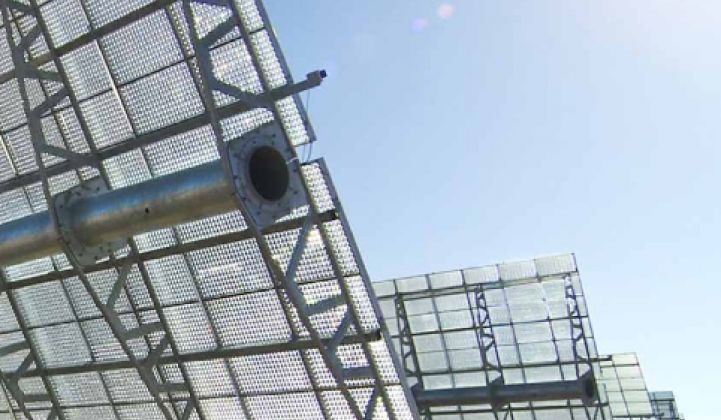The aisles and booths at Solar Power International, the biggest solar show in the U.S., once held scores of concentrating photovoltaic (CPV) firms -- but at last week's annual conference, there were none.
CPV has a 0.25 percent global market share of the 40 gigawatts of PV being installed in 2014. That figure comes courtesy of an optimistic forecast of 100 megawatts installed this year. Proponents tout CPV's benefits as being its low water requirements, low environmental impact, ease of permitting and less degradation. But compared to crystalline silicon, CPV's riskiness in terms of price, reliability and bankability have prevented the technology from achieving commercialization and scale.
So is CPV out of the race?
We've logged the attrition in this industry and keep an eye on the surviving aspirants. But there are really just three CPV survivors that are still hanging on to any semblance of a functioning commercial enterprise.
Soitec's vertically integrated CPV
The vertically integrated French firm Soitec builds its own multi-junction semiconductor, high-concentration PV systems, and also helps develop and finance its projects. Soitec's technology allows photovoltaic III-V semiconductor layers to bond together with a minimum of lattice-mismatch drama. The firm aims to get to 50 percent chip efficiency within the next few years and to reach module efficiencies approaching 40 percent.
Soitec recently re-announced a 150-megawatt module deal with a solar power provider and San Diego Gas & Electric as the power offtaker. The deal is not yet finalized, but it could mean that more than 80,000 CPV modules will be built at Soitec’s San Diego factory. This is not a new PPA with SDG&E but rather the sale of the four projects (for a total of 150 megawatts) under the PPA that SDG&E and Soitec signed back in 2011, as clarified by an SDG&E spokesperson.
Soitec built the 1.5-megawatt Newberry Solar 1 project in San Bernardino County, California, with power sold to Southern California Edison under a twenty-year PPA. Recently, Soitec christened the 1.3-megawatt Alcoutim CPV plant in Portugal and the 10.8-megawatt Borrego Springs site. Chinese solar project developer Focusic New Energy claims to have a 100-megawatt CPV pipeline, including the 20.5-megawatt Hami CPV power plant using Soitec modules. Soitec has a 44-megawatt project in Touws River, South Africa still in development and approximately 75 megawatts' worth of CPV projects in the ground.
SunPower's C7 low-concentration tracker in China
We shift technologies to SunPower's C7, a low-concentration (7X), high-efficiency silicon system.
When we last spoke with SunPower CEO Tom Werner, he said that the company was seeing "further traction" with the C7 tracker joint venture in China. Werner said that China is showing "accelerating demand" above the 15 megawatts of C7 cell receiver packages shipped in Q2 and the more than 115 megawatts of construction backlog, along with a claimed pipeline of approximately 1 gigawatt. Werner noted that while SunPower maintains its IP and ships the high-efficiency silicon receiver assembly, the balance of system (steel, trackers, concrete, etc.) gets sourced and supplied cheaply and appropriately in China, providing some hope for the embattled concentrator technology.
Investment firm Baird has suggested that SunPower's "C7 technology is not fully appreciated."
The company claims that its C7 Tracker has up to a 20 percent lower levelized cost of electricity than competing technologies, contending that it provides "the lowest levelized cost of electricity for utility-scale solar power plants available today." SunPower has also said that "a 400-megawatt C7 Tracker power plant requires less than 70 megawatts of SunPower solar cells."
Suncore mixes homegrown technology and acquisitions
Owned by LED chipmaker San'an Optoelectronics, Suncore offers a mix of CPV products and project services. Over the last few years, Suncore acquired the assets of Israel-based ZenithSolar, a combined heat and power CPV vendor, which claimed more than 70 percent combined efficiency. Suncore also acquired the remaining interest in Emcore's CPV business.
Tom Cheyney, Solar Curator, corrects the record and notes that Soitec's 44-megawatt flagship project in Touws River, South Africa will be the third largest CPV plant in the world, behind Suncore's 50-megawatt and 60-megawatt CPV plants in Golmud, China.
Like Soitec and SunPower, Suncore is backed by a large established entity with deep pockets and some patience, two traits necessary to play in CPV.
There are other CPV firms: Arzon is the company that remains after the venture capitalists departed from Amonix. Semprius, REhnu, Morgan Solar, Solar Junction, Banyan Energy, SolarSystems, Zytech Solar, Magpower, Ravano Green Powers, Cool Earth Solar and a few other startups are still hoping to innovate in the sector and keep up with the price of commodity silicon PV and natural gas. Cogenra, once a combined heat and power system vendor, moved to straight LCPV, and from there, recently pivoted to cell interconnects. Its LCPV system is a 14X concentration system using flat mirrors and high-efficiency solar cells, mounted on single-axis trackers.
The small vendors have challenges ahead as they confront the immense incumbency of silicon photovoltaics -- but without the benefit of a large corporate partner or balance sheet as enjoyed by Soitec, SunPower and Suncore.



